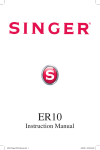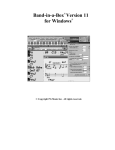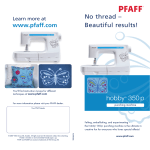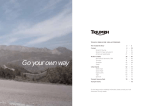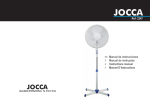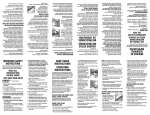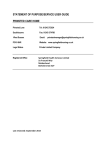Download Baby Lock embellisher EMB12 Instruction manual
Transcript
"IMPORTANT SAFETY INSTRUCTIONS" When using the needle felting machine, basic safety precautions should always be followed, Including the following. "Read all instructions before using". DANGER - To reduce the risk of electric shock. 1. The needle felting machine should never be left unattended when plugged in. Always unplug this needle felting machine from the electrical outlet immediately after using and before cleaning. 2. Always unplug before replacing light bulb. Replace bulb with same type rated 15 watts/110 volts in 110V/120V area. (15 watts 230 volts in 220V/240V area). WARNING - To reduce the risk of burns, fire, electric shock, or injury to persons. 1. Do not allow to be used as a toy. Close attention is necessary when the felting machine is used by or near children. 2. Use this needle felting machine only for its intended use as described in this manual. Use only attachments recommended by the manufacturer as contained in this manual. 3. Never operate this felting machine if it has a damaged cord or plug, if it is not working properly, if it has been dropped or damaged, or dropped into water. Return the needle felting machine to the nearest authorized Baby Lock retailer for examination, repair, electrical or mechanical adjustment. 4. Never operate the needle felting machine with any air openings blocked. Keep ventilation openings of the needle felting machine and foot controller free from the accumulation of lint, dust, and loose cloth. 5. Never drop or insert any object into any opening. 6. Do not use outdoors. 7. Do not operate where aerosol (spray) products are being used or where oxygen is being administered. 8. To disconnect, turn the main switch to the symbol "O" position which represents off, then remove plug from outlet. 9. Do not unplug by pulling on the cord. To unplug, grasp the plug, not the cord. 10. Keep fingers away from all moving parts. Special care is required around the felting machine needles. 11. Always use the proper needle plate. The wrong needle plate can cause the needles to break. 12. Do not use bent needles. 13. Do not pull or push fabric while stitching. It may deflect the needles causing them to break. 14. Switch the needle felting machine to the symbol "O" position when making any adjustments in the needle area, such as changing needles, changing needle plate, or changing cloth presser, and the like. 15. Always unplug the needle felting machine from the electrical outlet when removing covers, lubricating, or when making any of the servicing adjustments mentioned in the instruction manual. 16. Keep fingers away from moving parts, especially the area near the needles. 17. Please note that on disposal, this product must be safely recycled in accordance with relevant National legislation relating to electrical / electronic products. If in doubt please contact your retailer for guidance. 18. The appliance is not intended for use by young children or infirm persons without supervision. 19. Young children should be supervised to ensure that they do not play with the appliance. European Union only "SAVE THESE INSTRUCTIONS" "This needle felting machine is intended for household use." 1.Overview of Baby Lock Embellisher Cloth presser height adjusting screw Yarn port Yarn & ribbon guide Ribbon guide Handwheel Cloth presser Finger guard Needle plate Needle clamp holder Accessory storage Socket for foot controller Ribbon slot Power switch Sewing table Yarn Stand components Yarn stand Instruction book Yarn stand pin Washer Yarn threader Wing nut Foot controller Art of Embellishing Book Machine cover Detail of accessories (large:2mm) (small:1.5mm) Allen screwdriver Screwdriver Package of needle (#365A017) Lint brush 1 Tweezers 2. Setting Up Your Baby Lock Embellisher 1. Plug in the machine: Plug the power cord into the machine first, then into a wall outlet. Always make sure the power is off and remove the plug from the wall outlet when the machine is not in use, or when making any adjustments such as changing needles or light bulb. Available foot control for U.S.A.: Model EZ-168A. 2. Polarized Plug: This appliance has a polarized plug (one blade wider than the other). To reduce the risk of electric shock, this plug is intended to fit in a polarized outlet only one way. If the plug does not fit fully in the outlet, reverse the plug. If it still does not fit, contact a qualified electrician to install the proper outlet. Do not modify the plug in any way. 3. Foot control: The felting speed of the machine is determined by the amount of pressure applied to the foot control. When not in use, do not place anything on the foot control or the machine could start inadvertently and the foot control or motor could burn out. Cloth presser lifter lever Cloth presser Cloth presser height adjusting screw Turn right (clockwise) Turn left (counter-clockwise) Cloth presser is lowered Cloth presser is raised 4. Cloth Presser: The cloth presser is to prevent cloth/fabric/material from flapping during the felting process. Place the cloth/fabric/materials on the needle plate and under the cloth presser. Lower the cloth presser lifter lever. To adjust the height of the cloth presser, turn the cloth presser height adjusting screw until you get the correct height for your cloth/ fabric/ material. Turn the cloth presser height adjusting screw counter-clockwise to raise the cloth presser. Turn the cloth presser height adjusting screw clockwise to lower the cloth presser. The cloth/fabric/material should move freely under the cloth presser without any restrictions. 2 2. Setting Up Your Baby Lock Embellisher cont. 5. Set up yarn stand a) From the top side of the yarn stand, insert the threaded end of the yarn stand pin into opening in yarn stand. b) Place washer and wing nut on the threads of yarn stand pin and tighten with fingers. c) Insert the "L" shape side of yarn stand into slotted opening located on the back of the machine body. 3 3. Remove and replace Finger Guard Finger guard is a safety device to reduce risk of injury. If you would like to remove finger guard, special care is required around the felting needles. To remove finger guard: a) Open the lamp cover. b) Loosen the screw of finger guard by turning it counterclockwise. c) Remove finger guard. d) Retighten the screw slightly by turning it clockwise. This will prevent the screw from vibrating out. e) Close the lamp cover. To replace finger guard: a) Open the lamp cover. b) Loosen the screw for finger guard by turning it counterclockwise. c) Replace finger guard. d) Tighten the screw by turning it clockwise. e) Rotate handwheel several turns, making sure needle clamp and needle screws are not touching the finger guard. f) Close the lamp cover. 4 4. Start Embellishing Let your creativity soar with your new Baby Lock Embellisher! Now you can make your projects even more distinctive. Let your imagination run free with new ways to create beautiful felted embellishment on your crafts, home decorating, quilting, sewing, and scrapbooking. What kind of fabrics and trims can I use with the Embellisher? Just about any fabric can be felted with the Embellisher. However, some fabrics tend to have more favorable results after fabrics are laundered then used for embellishing. The recommended fabrics and trims are those made from natural fibers such as linen, wool, wool roving, and wool or cotton yarns. The best characteristic for fabrics is a napped or textured surface. A napped surface will adhere to a natural fiber/napped surface/or mixed fiber base. Avoid types of synthetics with "wash and wear" weaves and finishes which have a smooth surface. Can I launder my embellished projects? To determine if your embellished project is washable, it is recommended that you do a test sample first from the fabrics you intend to use. Wash the finished sample the same way you will wash it after the project is completed. For example, if you plan on washing and drying the completed project with a load of jeans, then do the same with the test sample. Do not "pamper" the test sample unless you plan on pampering the finished project. NOTE: Laundering rules of "pre-washing": Pre-washing all fabrics before sewing does not apply. With the Embellisher, you want the finished project to "shrink" so the felted fibers will stay meshed. With this in mind, be sure to make the project a little larger to allow for shrinkage. Because of not pre-washing fabrics before embellishing, color fading can occur when working with bright and contrasting colors. Be sure to make a test sample and wash it for best results. 5 4. Start Embellishing cont. Layer the cloth/fabric/materials that will be felted together to create the embellishment. Make sure the smaller piece to be felted is on the correct side of the project. NOTE:Depending on the look you want to achieve this can be either right or wrong side of project. Place the layers to be felted together under the cloth presser. Lower the cloth presser lifter lever. If needed, adjust the height of the cloth presser at this time so the project can move freely under the cloth presser. Move the cloth/fabric/materials in any direction so that the needles can mesh the layers together. ATTENTION: Always check to make sure the fabric under cloth presser will move freely or does not flap before embellishing. If necessary, adjust the cloth presser height adjusting screw. When you have finished embellishing, turn the handwheel toward you making sure the needles are completely out of the project. Never remove the embellished project with the needles in the project, as the needles can bend or break. NOTE: Always make sure the cloth presser lifter lever is lowered before starting to embellish. If the cloth presser lifter lever is not lowered, the materials can easily be lifted by the needles and can cause needle breakage. Remove the sewing table by sliding it to the left and the machine will convert to a free arm. This will allow you to embellish sleeves, pant legs, and small areas. This will also give you access to the free arm door to clean out the lint that has accumulated from embellishing. 6 5. Yarn Embellishing 1. Rotate the yarn & ribbon guide toward the back of the machine. Align the guide with the top of the yarn stand pin. 2. Place yarn or thread on the yarn stand and pull yarn end from center. 3. While sitting in front of the machine insert yarn into the third hole of the yarn & ribbon guide as shown in Fig. 1. 4. Wrap yarn to the underside of yarn & ribbon guide and insert into the second hole as shown in Fig. 2. 5. Once again, wrap yarn to the underside of yarn & ribbon guide and insert into the first hole as shown in Fig. 3. NOTE: If the tension of yarn is too tight, use only the third hole of yarn & ribbon guide. (Fig. 1) If this does not help the tension check that the yarn diameter is not too large. See page 8 for additional information. Fig. 1 Fig. 2 7 Fig. 3 5. Yarn Embellishing cont. Yarn threader 5. Rotate the handwheel to bring the needle bar to its highest position. 6. Raise the cloth presser lifter lever. 7. Insert yarn into the yarn port using the yarn threader. (Fig. 4) 8. Pull the yarn from the bottom of the cloth presser. (Fig. 5) 9. Place fabric under the cloth presser. 10. While embellishing with yarn, fabric may be moved in all four directions. (Fig. 6) 11. Lower the cloth presser lifter lever. Fig. 4 ATTENTION: Since there is such a wide variety of yarns to select from use care when using dense, fuzzy, or thick yarns. It is recommended to test sew a sample using all yarns before sewing on your project. Turn handwheel several times to insure there is no resistance with needle penetration. Yarn recommended for use in this machine should not exceed 4mm (5/32 inches) in diameter. Yarn needs to be able to slide freely within the yarn port. NOTE: If needle bar is not rotated to the highest position, the yarn will not go down through the inside of the needle bar. At the beginning of the yarn embellishing, slightly pull the end of the yarn. Fig. 6 Fig. 5 8 6. Ribbon Embellishing 1. Rotate the yarn & ribbon guide toward the back of the machine. Align the guide with the top of the yarn stand pin. 2. Place ribbon on the yarn stand. 3. Insert the ribbon into the slot of the yarn & ribbon guide. 4. Rotate the ribbon guide toward the front of the machine. 5. Insert the ribbon into slot of the ribbon guide. 6. Rotate the handwheel to bring the needle bar to its highest position. 7. Slide ribbon into the ribbon slot of the cloth presser. 8. Raise the cloth presser lifter lever. 9. Place fabric under the cloth presser. 10. Lower the cloth presser lifter lever. ATTENTION: Only guide the fabric towards the back of the machine while embellishing with ribbon or using the ribbon slot on the cloth presser to avoid the ribbon from getting tangled. NOTE: Maximum width of the ribbon slot is 10mm therefore ribbon over 10mm is not recommended for this machine. If ribbon is narrower than 10mm the needles will embellish on outside of ribbon area. Since there is such a wide variety of ribbons to select from use care when using dense or thick ribbons. It is recommended to test sew a sample using all ribbons before sewing on your project. Turn handwheel several times to insure there is no resistance with needle penetration. 9 7. Maintenance Changing the Needle(s) Use #365A017 needles for the Embellisher machine. Do not use any other type of needles Note: #365A017 needle is a very special needle and is exclusive for the Embellisher machine. See your Baby Lock retailer for replacement needles. Caution: When changing needle(s), unplug the power cord from the electrical outlet. Allen screwdriver 2mm Needle clamp fixing screw Needle fixing screws Allen screwdriver 1.5mm 1. Open lamp cover and remove finger guard. (see page 4.) 2. Turn the handwheel until the needle bar is at the highest position and then lower the cloth presser lifter lever. 3. Lower the cloth presser to the lowest position by turning the cloth presser height adjusting screw clockwise. 4. While holding the needle clamp holder, loosen the needle clamp fixing screw by turning the large 2mm allen screwdriver counter-clockwise. 5. Lower the needle clamp holder slowly into the cloth presser. The needles must not touch the cloth presser. Tilt the needle clamp holder slightly forward and remove it from the machine. 6. To remove the individual outer needles, loosen the needle fixing screw on the needle clamp holder by turning the small 1.5mm allen screwdriver counter-clockwise and remove the needle(s) by using tweezers. Insert the new needle(s) until the top of the needle touches the top of the needle hole. Tighten the needle fixing screw with the small 1.5mm allen screwdriver by turning the allen screw clockwise. Center needle is replaced by loosening the center needle fixing screw, replace needle and then tightening the screw. Note: #365A017 needles do not have a front or back, therefore, you can insert the shank of the needle in any direction. Red alignment mark Needle clamp fixing screw Needle plate 7. When replacing the needle clamp holder, make sure the needle bar is in its highest position. Tilt the needle clamp holder so the needles will slide into the cloth presser and slide the clamp up onto the needle bar until the red mark on the needle bar and needle clamp holder align. Tighten the needle clamp fixing screw by turning with the large 2mm allen screwdriver clockwise. Adjust the cloth presser to desired height. 8. Replace finger guard and close lamp cover. 10 7. Maintenance Cont. Replacement of light bulb Swing the lamp cover towards the left to open. Remove the light bulb and replace with new one that is the same type rated 15 watts/120 volts or 15 watts/230 volts. ATTENTION: To prevent possibly injury, unplug main power cord prior to replacing light bulb. Make sure the light bulb is cool to the touch before removing it from the machine. Cleaning Remove the sewing table and open the free arm door. Clean the lint from inside free arm door, needle clamp holder, cloth presser and needle plate periodically. Dust or lint may cause needle breakage. Lubrication Lubricate with one or two drops of oil when necessary. See the illustration showing the oiling points in the machine. For recommended oil for your machine please contact your Baby Lock retailer. 11 Trouble Shooting Needle bent or needle breakage: 1. Are you moving the materials too quickly? 2. Are the needles touching the cloth presser or needle plate? 3. Is there dust or lint around the edge of the needles, cloth presser, or holes of the needle plate? 4. Does the free arm area need to be cleaned? For problems other than bent needles or needle breakage, please contact your Baby Lock retailer. Specifications Needle: #365A017 Number of needles: 12 Needle clamp holder: Round type (2.5 intervals between needles) Feeding: Manual Light bulb: 15W/120V or 15W/230V Measurement: 15.9" x 6.7" x 11.8" (height) 405mm X 170mm X 300mm (height) Weight: 12.8 pounds 5.8kg 12 EMB12 EI-35-Ta 2008.8.1200

















